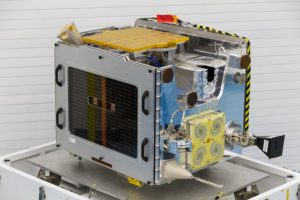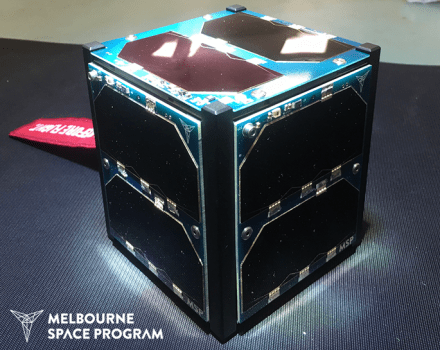A sampling of recent articles, press releases, etc. related to student and amateur CubeSat / SmallSat projects and programs:

** Cranfield University team’s Icarus-1 drag sail successfully deployed on Surrey Satellite’s TechDemoSat-1 smallsat in orbit back in May: TechDemoSat-1 on-board camera captures drag sail deployment | SSTL
TechDemoSat-1, a 150 kg in-orbit technology demonstration small satellite mission, validated 8 innovative UK spacecraft instruments and software payloads and also acquired ocean wind speed datasets using GNSS reflectometry.
The deployed sail measures approximately 6.7 m2 and is designed to significantly increase the spacecraft’s rate of orbital decay, in compliance with current Space Debris Mitigation best practice and guidelines.
Stephen Hobbs, Head of Cranfield University’s Space Group, commented “At Cranfield we are delighted to see our Icarus de-orbit technology demonstrated successfully in orbit – again. With the Icarus sails now deployed on both TechDemoSat-1 and Carbonite-1, SSTL and Cranfield have demonstrated clear leadership in this technology. We hope to see many more satellites following TechDemoSat-1’s example to keep space clear of debris. It’s been great to work with SSTL on this mission.”
The Icarus-1 drag sail consists of a thin aluminium frame fitted around one of the external panels of the spacecraft in which four trapezoidal Kapton sails and booms are stowed and restrained by a cord. Deployment is achieved by activating cord-cutter actuators, allowing the stored energy in the spring hinges to unfold the booms and the sail.

** The Planetary Society’s LightSail-2 to launch on the SpaceX Falcon Heavy STP-2 mission. The sail follows several previous solar sail projects (Japan’s IKAROS 2010 was the first to demonstrate sunlight driven propulsion) and aims to be the first of the Society’s sails to demonstrate net thrust. The sail will be released from the Georgia Tech Prox-1 carrier satellite (see below) about a week after the launch.
Follow progress with the mission at:

Resources:
- LightSail Press Kit | The Planetary Society
- Ecliptic Enterprises Corp. led the consortium that built the spacecraft.
- LightSail 2 set to launch next month aboard SpaceX Falcon Heavy rocket | The Planetary Society – May.13.2019
- Cal Poly tech to launch into space on Monday with historic LightSail 2 on board | KSBY.com
- Carl Sagan’s Solar Sail Is Finally Ready To Fly – Popular Mechanics
LightSail-2 teleconference (transcript (pdf)) with
- Bill Nye, CEO of The Planetary Society
- Bruce Betts, Chief Scientist and LightSail 2 Program Manager
- David Spencer, LightSail 2 Project Manager and Associate Professor at Purdue University
- Jennifer Vaughn, COO of The Planetary Society
** Georgia Tech’s Prox-1 smallsat was built by students and will be student-operated as well. The goal of the mission is to
… demonstrate proximity operations for space situational awareness, through the use of a low thrust propulsion system for orbital maneuvering, and visible and infrared imaging for reconnaissance. The Prox-1 mission is directly applicable to Air Force Space Command’s priority to develop and maintain complete knowledge of assets in the on-orbit environment.
Prox-1 will conduct rendezvous and proximity operations with an on-orbit “objective”: the expended launch vehicle that delivers Prox-1 to orbit. Through multiple circumnavigations of the objective while acquiring visible and infrared images, a three-dimensional model of the objective will be developed and material properties will be established. The orbit of the objective will be determined, and a time-history of the objective attitude will be acquired. As an extended mission goal, Prox-1 will conduct proximity operations with additional objects in the near-space environment. The primary mission duration is three months.
This animation is somewhat dated but shows the primary operational tasks of the mission:
See also The Future Is Small – Georgia Tech’s Research News – 2015
** Northwestern Univ. & Univ. of Illinois students work to get SpaceICE CubeSat ready for space after the project missed the first launch opportunity.
we are sending freeze-casting to Low Earth Orbit! At Northwestern, we are designing the experiment and payload, while UIUC (CubeSat Project) is building the satellite. This project is funded by NASA’s Office of Education through the Undergraduate Student Instrument Project. Our anticipated launch date is late 2018.
Once in orbit, we’ll collect image and temperature data while freezing aqueous suspensions of silver coated glass beads and salt water solutions. Whereas we were limited to freezing very quickly during our parabolic flight work, the CubeSat platform will allow us to test a range of freezing velocities.
Here is a history of the SpaceICE CubeSat project: Despite launch delay, NU undergrads plow ahead with redesign for NASA freeze-casting experiments | Medill Reports Chicago
Young scientists are racing to deliver by October a satellite payload of instruments to test freeze-casting — technology that could free space explorers from expensive, time-consuming deliveries of supplies from Earth.
The team of Northwestern University undergraduates building the innards for a small satellite called a “CubeSat” missed the launch window last year but are getting ready for another try.
“The sample container failed,” explains Kristen Scotti, a graduate student and mentor for SpaceICE, the initiative creating the CubeSat instrumentation to test freeze-casting for eventual manufacturing needs in space. Essentially, the glass containers for three sample suspensions were cracking, and anything less than airtight would jeopardize the freeze-casting process, dependent upon controlled temperatures and accurate readings.
** Several university teams win grants for Phase 1 of National Geospatial-Intelligence Agency’s MagQuest, “a $1.2 million global open innovation challenge to advance how we measure Earth’s magnetic field” – NGA announces 10 winners in MagQuest Phase 1; launches $1 million Phase 2 – GeoSpatialWorld.net
MagQuest is designed to attract new ideas to increase the efficiency, reliability, and sustainability of geomagnetic data collection. With this open innovation challenge, NGA is inspiring solvers to apply their expertise to a wide range of potential solution areas. “From seafloor observatories to satellites, the breadth of ideas that emerged from Phase 1 of MagQuest is impressive and energizing,” said Richard Salman, Director of NGA’s Office of Geomatics. “We look forward to seeing the novel thinking and new technologies solvers will bring to Phase 2 of the challenge.”
** Nepal and Sri Lanka now have their first satellites in orbit. The BIRDS 3 CubeSats were built in collaboration with Japan’s Kyushu Institute of Technology, whose BIRDS project is intended to help non-spacefaring developing countries get into orbit. (See posting here.) The Birds-3 satellites were deployed from the ISS into orbit last week. ISS crew member Nick Hague posted images of the deployments:
Yesterday I monitored the deployment of 4 small satellites (CubeSats), as they were ejected outside of the JEM laboratory on @Space_Station. The first set of CubeSats deployed were from Nepal, Sri Lanka & Japan, & the last CubeSat was from Singapore. https://t.co/3YIvo0P40B pic.twitter.com/DAKvl2mskj
— Nick Hague (@AstroHague) June 18, 2019
This video shows the Birds-3 deployment at around the 15:15 point:
Singapore’s Spooqf-1 cubesat is deployed at around 20:15. The Spooqf-1 is a project of “a multi-disciplinary group at the Centre for Quantum Technologies in Singapore […] located on the National University of Singapore campus”. The “Quantum Nanosatellite” is testing entangled photon encryption communication technologies. SpooQy-1: Singapore’s experimental quantum CubeSat and its Kibo launch | SpaceTech Asia.
** AMSAT news on student and amateur CubeSat/smallsat projects: ANS-174 AMSAT News Service Special Bulletin
- Candidates for the AMSAT Board of Directors Announced
- Help Celebrate AMSAT’s 50th Anniversary – Take W3ZM on the Road!
- Lightsail-2 Scheduled for Launch June 24 – Beacon on 437.025 MHz
- NASA Lightsail-2 PR and TV Coverage
- Listening to Lightsail-2 Co-passengers
- AMSAT President Joe Spier Speaks With SIP Interns
- Upcoming Satellite Operations
- ARISS News
- How to Support AMSAT
- Shorts From All Over
General CubeSat/SmallSat info:
- Resources:
- What’s inside a CubeSat? | Engineering360
- Small Satellites | NASA
- Small Satellite Conference – 33rd AIAA/USU Conference on Small Satellites – August 3-8, 2019, Utah State University, Logan, Utah.
- Projects:
- SIMPLEx Small Satellite Concept Finalists Target Moon, Mars and Beyond | NASA
- Small Satellite Concept Finalists Target Moon, Mars and Beyond – NASA JPL
- Former ABS execs form small GEO builder Saturn Satellite Networks – SpaceNews.com
- GomSpace to Design Worlds First Stand-alone Nanosatellite Asteroid Rendezvous Mission | newkerala.com
- Watch: Young women aim to build Kyrgyzstan’s first satellite | Euronews
- Australia cubesats:
- Cubesat training and research centre launches – Computerworld [Australia]
- Senator the Hon. Arthur Sinodinos AO officially opens CUAVA – CUAVA
- CUAVA (ARC Industrial Transformation Training Centre for CubeSats, UAVs, and Their Applications)
====






